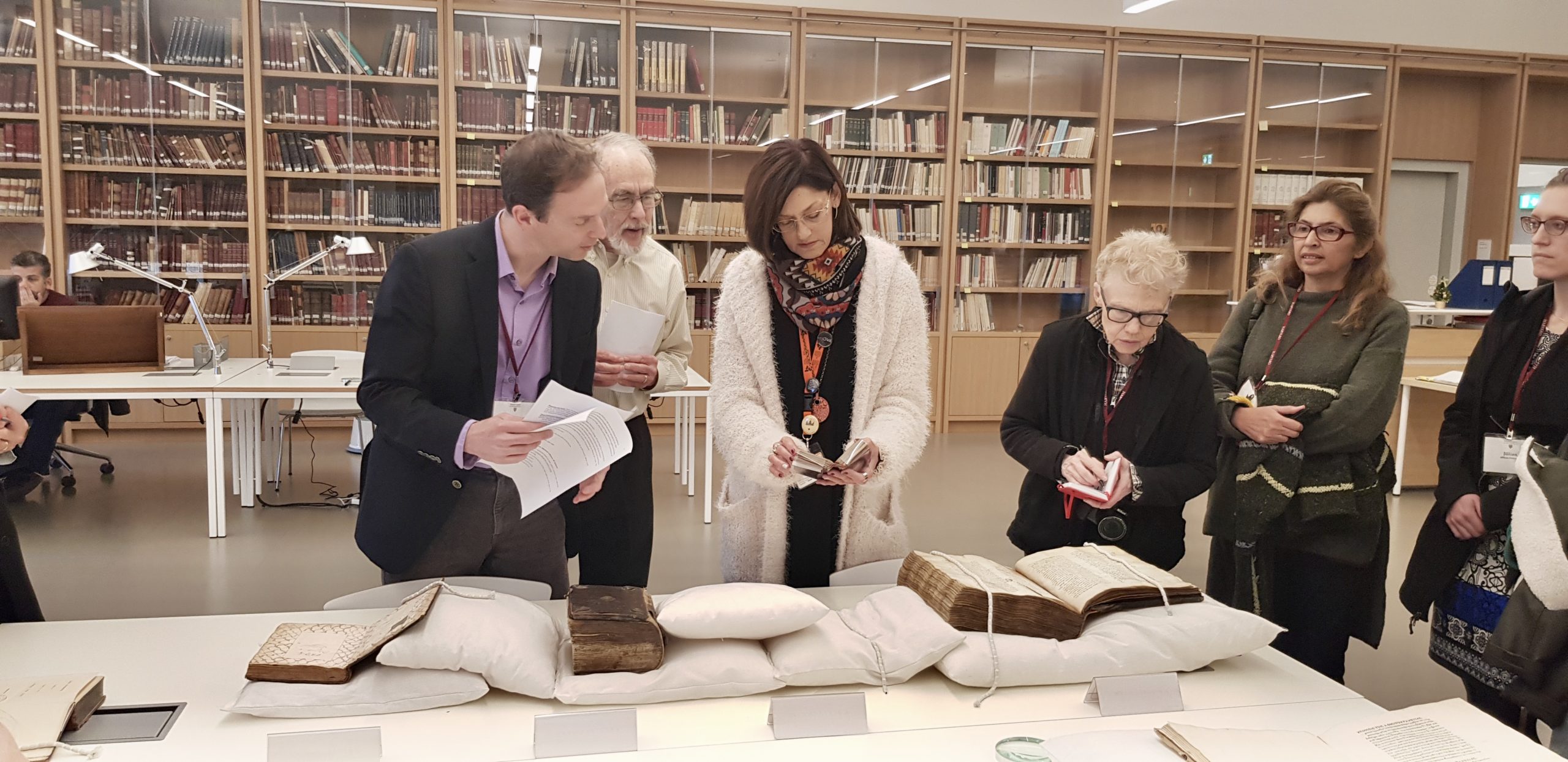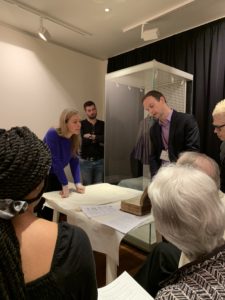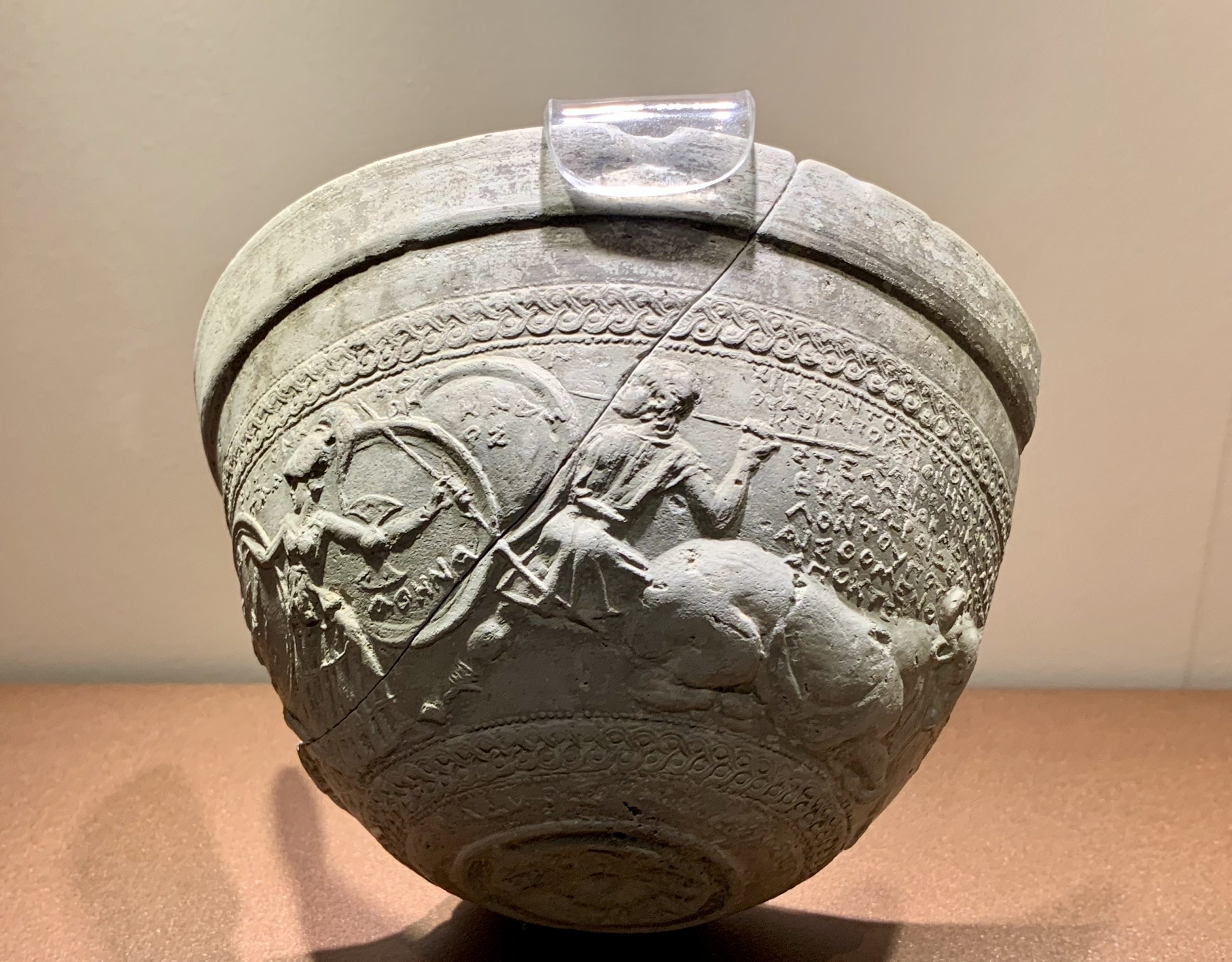L’univers est une espèce de livre, dont on n’a lu que ta première page quand on n’a vu que son pays.
The universe is a kind of book of which one has read only the first page when one has seen only one’s own country.
From de Montbron, Le Cosmopolite, quoted by Lord Byron in the “Preface to the First and Second Cantos” of Childe Harold’s Pilgrimage
When I received the proposal for this trip I realized it was a great opportunity to reunite my two interests in Greece: my deep love of Ancient Greek philosophy, myth, religion, and poetry, with my absolute fascination for Modern Greek history, literature, and the contemporary Greek way of life.
Moreover, as a literary editor, I found the development of writing from syllabic Linear B to the adaptation of the Phoenician alphabet that evolved into the Greek alphabetic writing, and the material aspect of scripture as well—the use of stone, clay, parchment, papyri, paper altogether with the forms of deploying it in scrolls, codex, or books and the implements with which to write on them—so challenging that I did not hesitate to jump into it.
It all went well from the beginning. We were a small group and immediately found a close connection.
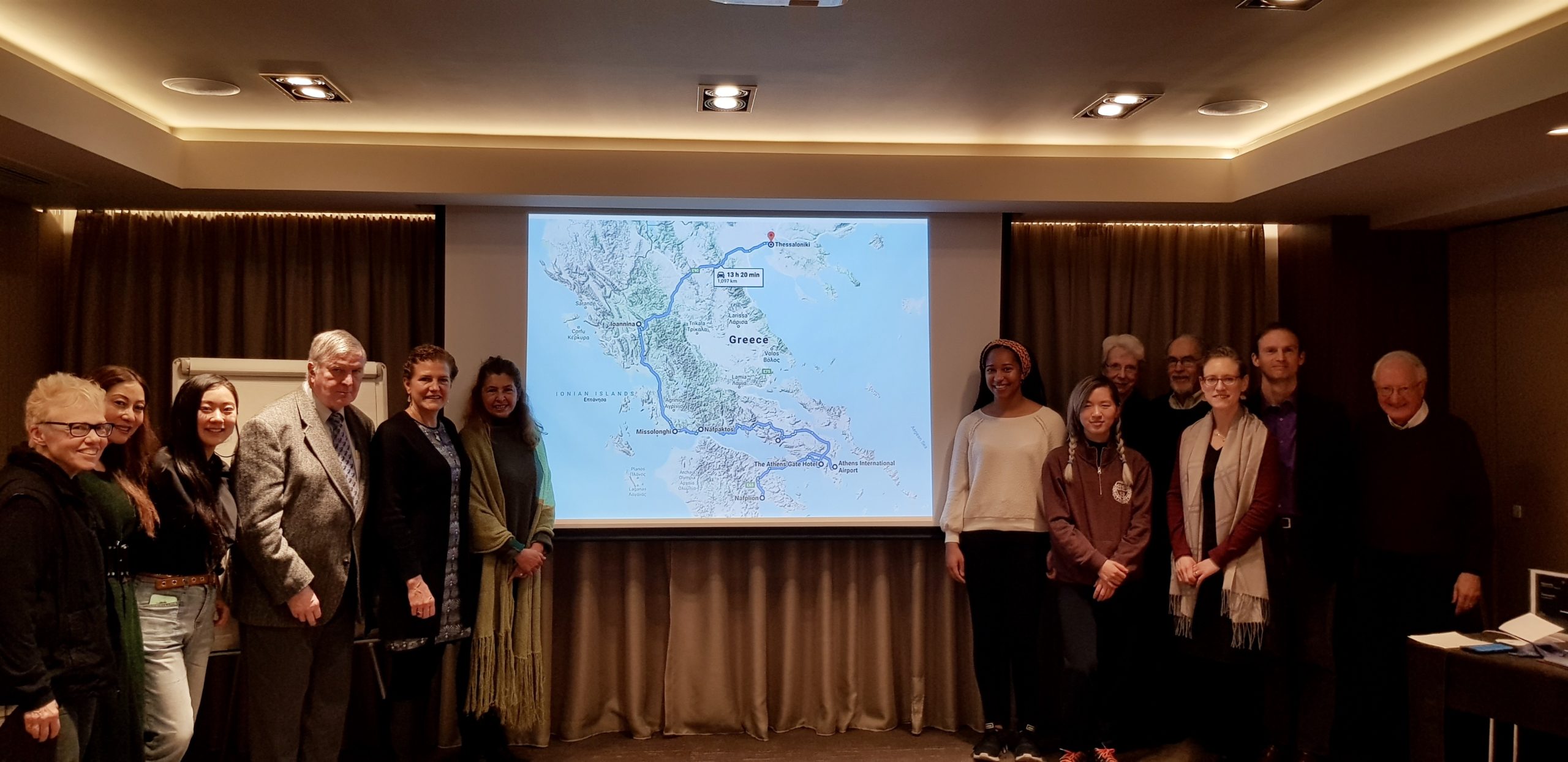
I very much remember our first dinner together at Napflio, the first place we visited, because as we were about to finish we were surprised with a Vasilópita to celebrate the birthday of one of our fellow travelers, David.
The Vasilópita is a traditional cake, “the pie of Basil,” and its cutting commemorates a legend associated with St. Basil the Great, who lived 330–379 CE. He is the patron saint of children, orphans, and the poor, and was particularly known for helping and giving to the poor. He is the Greek equivalent of Santa Claus, bringing gifts to children on January 1st, his Name Day, rather than at Christmas. This cake was well timed to celebrate both St. Basil and David´s birthday as we were starting our trip in early January.
But there is more about the tradition of this pie. The legend tells that St. Basil gave his own possessions to the poor. He was the guardian of the riches of the people of Caesarea and so was responsible for returning them to the people. And, since it was not known who owned what, St. Basil had all the gold, silver, and valuables baked into a large pita, which he then cut and distributed to the people. Miraculously, everyone received his own and rightful valuables.
In commemoration of this episode the tradition is that, at midnight on New Year’s Eve, the head of each family marks the sign of the cross over the Vasilópita, a rich cake which has been baked containing a hidden coin, and then proceeds to cut it into pieces, always in a particular order. Usually, the first piece is for Christ, then perhaps the Virgin Mary, St. Basil, the house, or the poor, followed by each family member, starting with the head of the household, and proceeding down by age. The one who receives the coin will enjoy good luck for the coming year and often is also given a small gift or money.
So, we cut the Vasilópita that night after having heard Evan, our dear trip organizer, and Connie, one of our fellow travelers who has been living in Greece for a long time, sing the Χρόνια Πολλά [Chrónia Pollá] (a Greek “Happy Birthday”). I was carried away by the sweetness of Connie’s voice—then she told us she sang in a choir—but also and especially I was impressed by the depth of the words of that song:
To live well (David), and for many years
May you live to be old, with white hair
To scatter everywhere the light of knowledge
And may everyone say, here is a wise one!
I found the image of the grey hair as a mirror of wisdom so touching that I felt that an extraordinary welcome in Greece was actually taking place and took it as a sēma to discover what a profound culture was awaiting us.
The following day we started our itinerary visiting the Archaeological Site of Mycenae with the beehive tomb (the “Tomb of Agamemnon,” also known as the “Treasury of Atreus”), the Cyclopean walls, the wonderful Lion Gate, the Megaron at the top, the mountains and the blowing of the wind… At once, the whole setting for many of the heroes I admired in the epics, poems, and tragedies was all there in front of me!

Once at the museum we could admire the clay tablets with the Linear B fragments and listen carefully to the explanation of Keith, our great trip leader.
Our next destination was Athens.
For me the most exciting part of this time in Athens was that—in addition to the classical spots such as the Agora, the Acropolis, and the Parthenon Museum, which we could visit in our free time on our own—as a group we dedicated this opportunity in the city to visit most specific places from which we could obtain a taste of the evolution of history in this culture from ancient, through Byzantine, and to contemporary times.
Examples ranged from the “Dipylon Oinoche” at the National Archaeological Museum, the earliest Greek alphabetic inscription of a text with syntax (740 BCE), to other attestations we saw at the Epigraphic Museum of early alphabetic Greek scripture from archaic period, some of them bilingual Greek and Phoenician such as the “Delos Inscription,” to Classical and Hellenistic age examples as well.
We also saw how Greek language continued to be written in Byzantine times in vertical scrolls and icons that we admired at the Byzantine Museum. There, we could witness the restoration in progress of an original parchment scroll of 1301 BCE, Emperor Andronikos II’s chrysobull with his signature in red!
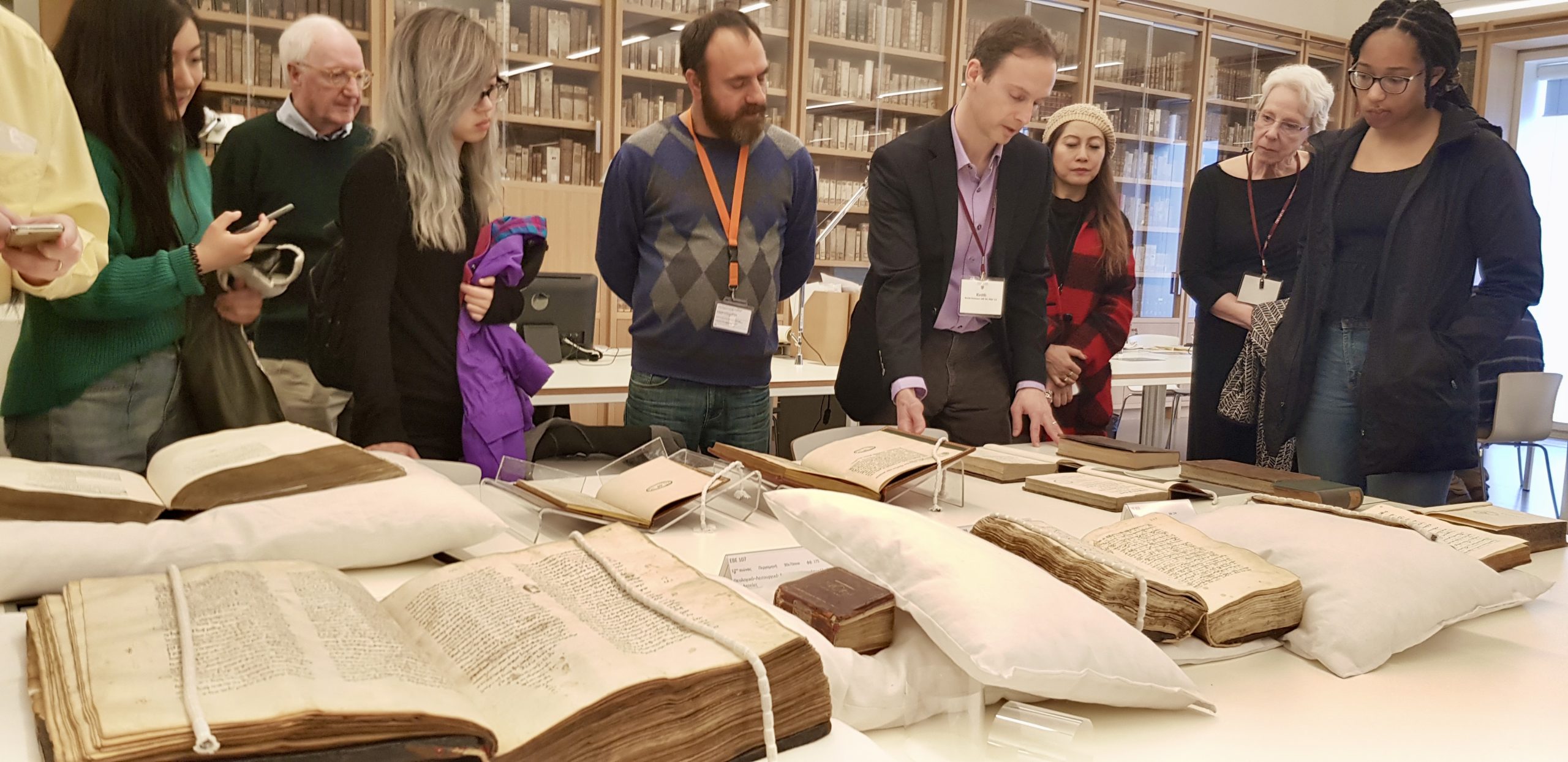
We also visited the National Library in the extraordinary contemporary building of the Stavros Niarchos Foundation (where the Greek National Opera is also hosted). This Cultural Complex is worth seeing for itself. It is a very impressive masterpiece of contemporary architecture by Renzo Piano, immersed in a park of 170,000 square meters. The building emerges as a link between the city and the sea, the past and the present, and is absolutely sustainable. The roof is covered with 10,000 square meters of photovoltaic cells, enough to generate 1.5 megawatts of power for the library and opera. This field of cells allows the building to be energy self-sufficient during normal opening hours.
From its terrace, visitors can enjoy breathtaking views of the city and to the ports of both Piraeus and Faliro. That was a special occasion for a group photo!
At the Library, we were received by the Rare Books Department team and enjoyed an extraordinary conversation as we proceeded to look at the manuscript codices and the first samples of printed books. We could grasp a sense of the evolution of the different phases from codex to printed books but also of the development of the language.
I very well remember that we discussed the so-called “Greek language question” that focused on the controversy of Katharévousa, which was an official form of Greek, now defunct, that resulted from the “correction” of modern Greek words and forms according to Ancient Greek usage, and Dimotikí, today’s standard Modern Greek.
Among the pieces, we saw an 9th-century CE parchment manuscript codex of the Homilies of Saint John Chrysostom (Χρυσόστομος = “Golden mouth”), a Byzantine bishop who lived between 347 and 407 CE, known for the beauty and eloquence of his sermons. We also saw one of the first grammar books printed in Greece (15th century CE) and a later printed book of Homer Iliad.
A visit worthy of note was that to the Jewish Museum where we had a workshop with one of the specialists of the museum. We learned that Jewish people started to move through the Mediterranean from 587 BCE, that the first attestation of a Jewish person in Greece is from 300 BCE, and also which were the main centers of Greek-Jewish life, such as Salonika (= Thessaloniki), the largest Jewish community up to 1920.
The Museum has an incredible collection of horizontal scrolls and books and reading implements, ranging from Torah scrolls, always in parchment, to books of prayers and instructions for Pesach, to Jewish newspapers. It was exciting to discuss every detail with our host at the Museum and with Keith.
I was so happy to appreciate how well had Keith thought and prepared every detail of our trip, always focusing on his inspiring proposal. Everything made sense! We learned very much and also had our moments to socialize and share both our interests and what we were experiencing as a group.
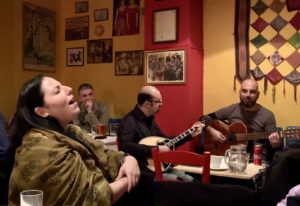
By the way, one of the highlights of our stay in Athens was the dinner at a wine kitchen (οινομαγειρείο, oinomageireío) where we enjoyed rebétiko music whose feeling of uprooting and marginality, sadness and despair, love and other strong human emotions are so intense that you cannot remain indifferent. You are absolutely dragged into all these emotions at once!
That evening we met Helene, an Athenian participant of Kosmos Society, and we had the honor to be joined by the poet Agathi Dimitrouka and her niece, Nikoletta, who at one moment of the evening started to sing with the musicians with so sweet a voice that it was really as if the sublimity of a Muse had taken possession of her. Something was really happening there! At once, Agathi shut her eyes and started moving, first her hands, then her arms, her head… and immediately the dance flowed…
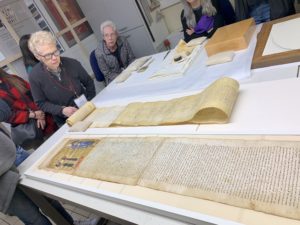
But let me tell you more about that night because it had a special bonus for me. It is hard to describe the joy I experienced when Agathi gave me her last book of songs/poems where she works with ancient poetry and songs in a so powerful creative poetic rewriting of her own that reaches the contemporary reader with the experience of a reenactment of that rich and old tradition with almost imperceptible changes with which Agathi manages to make them powerfully new, still today. What a surprise I had when I opened the book and found that the first poem/song mirrored one epigram of Nossis, a Greek female poet of the 3rd century BCE on whom my publishing house happened to be working and translating into Spanish!!!!
Nothing is sweeter than love and all the other blessings
comes second. I spat even honey from my mouth.
Nossis says this: Whosoever had Cypris not loved
does not know her flowers, what kind of roses are.Nossis, “To Love”
“Nothing is sweeter than love.
I have spat from my mouth
even honey.
All things which bring happiness come second.”
This is what Nossis tells us
and you young ones should listen.
Whosoever, alas!, has not been loved by Aphrodite,
neither knows nor will learn
what is a rose, what is a thorn.Agathi Dimitrouka
After Athens, our trip continued in Thebes where we visited its outstanding Archaeological Museum. I very much enjoyed the pieces related to the Thebans’ mythology, such as the Skyphos with a relief representing the foundation of Thebes by Kadmos who in the myth was said to have introduced alphabetic writing, and a votive relief of Herakles receiving the horn of Amaltheia and the vases depicting Dionysus.
And, of course, we saw many attestations of writing from Linear B in the Mycenaean Period and alphabetic writing in pieces testifying to the delivery of goods as oil, wheat, barley, and wool.
We continued our journey to Mesolongi but first we stopped for the night in a lovely seacoast town with a castle and a fortress, named Nafpaktos. It was a nice occasion to stroll about.
Mesolongi was a big surprise for me as we could grasp that intense motivation and feeling of the whole of Europe and America for Greece.
This city is the emblem of the Greek War of Independence (1821–1830 CE), a place where they struggled for liberation from the Ottomans who besieged the town twice. In the second siege, the city was utterly devastated and almost all the people were brutally killed.
This war had a close connection with the poets and painters of Romanticism, who viewed Greece as a symbol of European and Occidental identity, and who traveled there to assist and fight with them for freedom. Lord Byron was the main example. He lived and died in Mesolongi and the letters he wrote from there count as the most powerful, inciting people to come and fight for Greece.
We visited the Museum of History and Art that displays the first Greek newspaper and heard about the role it played in the war and the history of the “Exodus” (the attempt of the besieged residents of Mesolongi to break out) We also went to the Garden of Heroes where there is the Byron memorial, and where soldiers of different nationalities, even Americans, are buried.
So, this city is mainly known for the Greek War of Independence but also is proud of its mythical past. The Iliad accounts for this city, in the Catalogue of Ships (Iliad 2.638–644), for having contributed forty black ships.
Furthermore, in modern times, one of the Greek national poets, Kostís Palamás (1859–1943 CE) was raised in Mesolongi where today you can visit his house, now turned into a museum.
After lunch in Mesolongi we drove directly to Ioannina, a vivid city by a beautiful lake where we visited the Museum of Typography and Graphic Arts Technology of the University of Ioannina. There, we learned about how the Venetian printers of the Italian Renaissance, who were Greek themselves, introduced the first printing machines in Greece and brought with them one thousand types. At the end of the visit, we ourselves could print, in one of the presses of the museum, the first lines of Cavafy poem “Ithaka.”
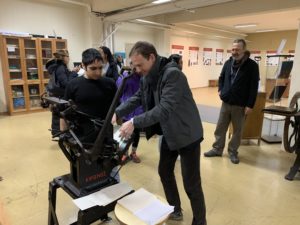
At the Library, we could appreciate a 16th-century CE Psalms Book printed in Italy with eight columns in different languages, among them Hebrew, Aramaic, Latin, Greek and Arabic. We also saw books in Ottoman writing.
At last, we reached Salonika. This large town—the second Greek town in population—in Macedonia, the land of Alexander the Great, was one of the most important centers of the Byzantine Empire and was the final destination of our trip.
One of our most extraordinary visits in the city was the Museum of Byzantine Culture Conservation Workshop where we learned about papyri, parchment, and papers, and we were given a demonstration of how parchments were prepared before writing on them. But what I enjoyed the most was the experience of how to recognize the quality of parchment when we were allowed to touch them and feel the thickness or thinness of some samples, and asked to observe how the side of the parchment that corresponded to the flesh or the hair of the animal varied, since the former is whiter and the latter is darker.

In the free time in the city, I did not miss the opportunity to visit the Archaeological Museum to see the Derveni Papyrus, a papyrus roll from 340 BCE, with an allegorical commentary of an Orphic Theogony poem.
A most interesting place we visited to end our trip through the history of writing was a modern printing facility where we witnessed all the modern process of the printing of a book. That was amazing because it was the same process we use in my little publishing house in Argentina to make our own books. So, in our last review meeting at the hotel, before our farewell dinner, I shared with the group that experience and showed our Sappho Spanish version book with drawings by my husband Remo Bianchedi, a well-known Argentinian artist. It was a very significant way of closing this trip!
But you see “closing” is only a way of saying though actually something impossible to do since, as Cavafy’s poem says, Ithaca is not a place of destination but a privileged way to be in our own existence, a life of wandering about, where we get lost and found, again and again, encountering ourselves facing our inner Cyclops and monsters as islands and ports and feeling that the trip is worthwhile only because we are experiencing it:
As you set out for Ithaka
hope your road is a long one,
full of adventure, full of discovery.
Laistrygonians, Cyclops,
angry Poseidon—don’t be afraid of them:
you’ll never find things like that on your way
as long as you keep your thoughts raised high,
as long as a rare excitement
stirs your spirit and your body.Translation by Edmund Keeley, Poetry Foundation
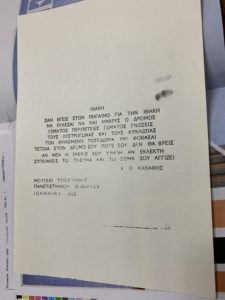
By the way, I always carry with me the printed fragment of “Ithaka,” the poem we printed in Ioannina, both in my bag and in my soul.
___
María Eugenia Romero completed HeroesX and is a member of the Kosmos Society.
First published in July 2020.
Photo Credits: Constance Anderson, and Evangelos Katsarelis, participants on the trip, with permission.

